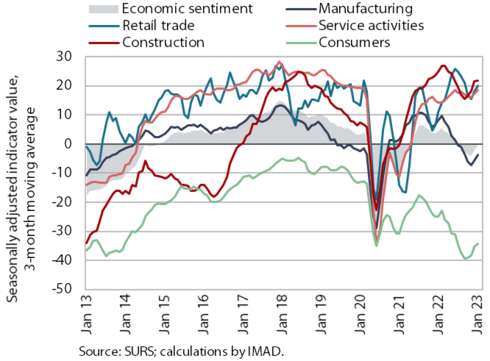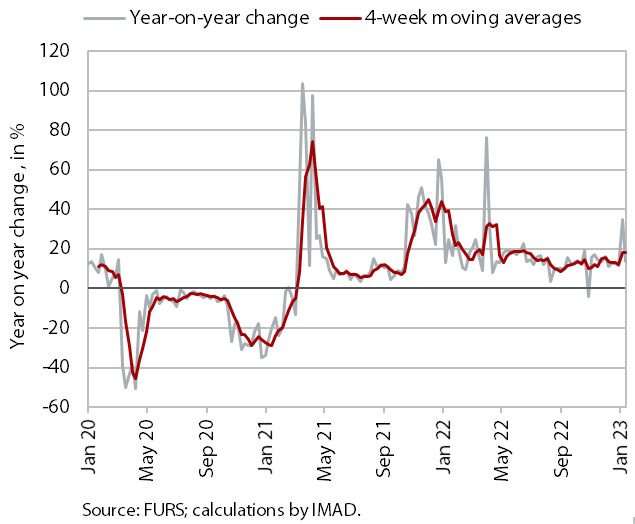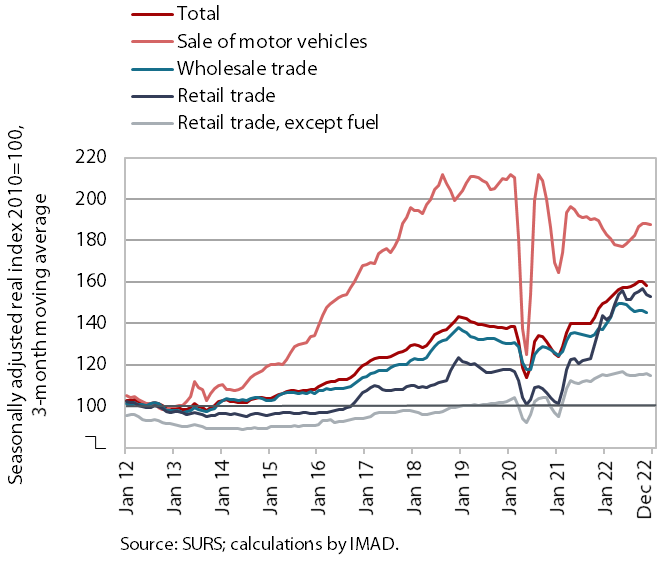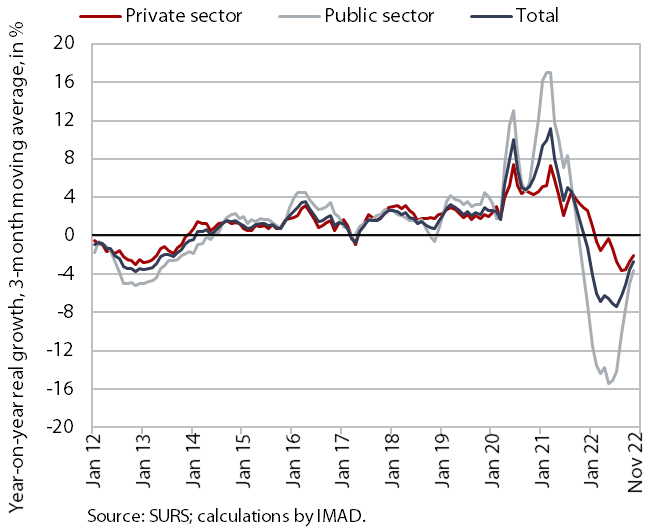Charts of the Week
Charts of the week from 23 to 27 January 2023: economic sentiment, value of fiscally verified invoices, turnover in trade and average gross wage per employee
After improving for two months, the economic sentiment deteriorated in January. The year-on-year decline in confidence remains strongest among consumers and in manufacturing. Confidence is also deteriorating in services and retail trade, although it is still higher than a year ago. Amid high price growth, the value of fiscally verified invoices was more than a fifth higher year-on-year in nominal terms in mid-January, mainly due to the low base from last year. In the fourth quarter of last year, turnover declined in most trade sectors. The real decrease in wages in November was cushioned by the 13th month payments and Christmas bonuses and by wage increases in the public sector.
Economic sentiment, January 2023

Economic sentiment stopped improving in January. After improving slightly in November and December last year, the economic sentiment deteriorated again in January and was also lower year-on-year. Compared to the previous month, the largest decline in confidence was recorded among consumers, in construction and retail trade, followed by a slightly less pronounced decline in service activities. Confidence in manufacturing remained similar to the previous month. Only confidence in retail trade and service activities was higher year-on-year, while it was significantly lower than a year ago in other activities. The sharpest year-on-year decline in confidence was recorded among consumers and in manufacturing. Consumers feel that high prices are reducing their purchasing power, and they are also pessimistic regarding major purchases and the country’s economic situation. Manufacturing companies continue to report a decline in new orders and are under pressure from the current international environment.
Value of fiscally verified invoices, in nominal terms, 8–21 January 2023

Amid high price growth, the nominal value of fiscally verified invoices between 8 and 21 January 2023 was 23% higher year-on-year. Year-on-year nominal growth, which had been just above 10% in the previous weeks, strengthened mainly due to higher growth in trade, which doubled (to 22%). We estimate that in addition to the high price increase this was due to low consumption last year, which was affected by an increase in the number of Omicron infections in January last year. Nominal turnover growth also remained high in accommodation and food service activities (44%), certain creative, arts and entertainment activities, sports activities, and gambling and betting activities (overall 52% growth in R,S,T services).
Turnover in trade, November–December 2022

Turnover fell in most trade sectors in the last quarter of 2022. More rational consumption in the face of high price increases was most pronounced in the retail sale of food, beverages and tobacco, where turnover in the fourth quarter fell significantly compared to the third quarter and was also considerably lower year-on-year (by 4.6%). Turnover in the sale of motor vehicles also remained lower than a year ago, although it rose slightly for the second quarter in a row as supply chain bottlenecks eased. In October and November, turnover also declined in wholesale trade, where year-on-year growth also continued to weaken. Turnover in the retail sale of non-food products increased slightly in the fourth quarter due to growth in November, but year-on-year growth (1.1%) was lower than in the previous quarter.
Average gross wage per employee, November 2022

Amid high inflation, the average gross wage fell by 2.1% year-on-year in real terms in November. In the private sector, the year-on-year decline in real terms (1.5%) was lower than in previous months, also due to extra payments (13th month payments and Christmas bonuses), which were higher than in November 2021. The average wage was higher year-on-year in transportation and storage, and accommodation and food service activities, which also face above average labour shortage. In the public sector, the year-on-year decline in real terms (3.2%) was similar to that in October, when the agreement on the wage increase entered into force. Compared to November last year, the average gross wage increased by 7.7% in nominal terms – by 6.5% in the public sector and by 8.3% in the private sector.
